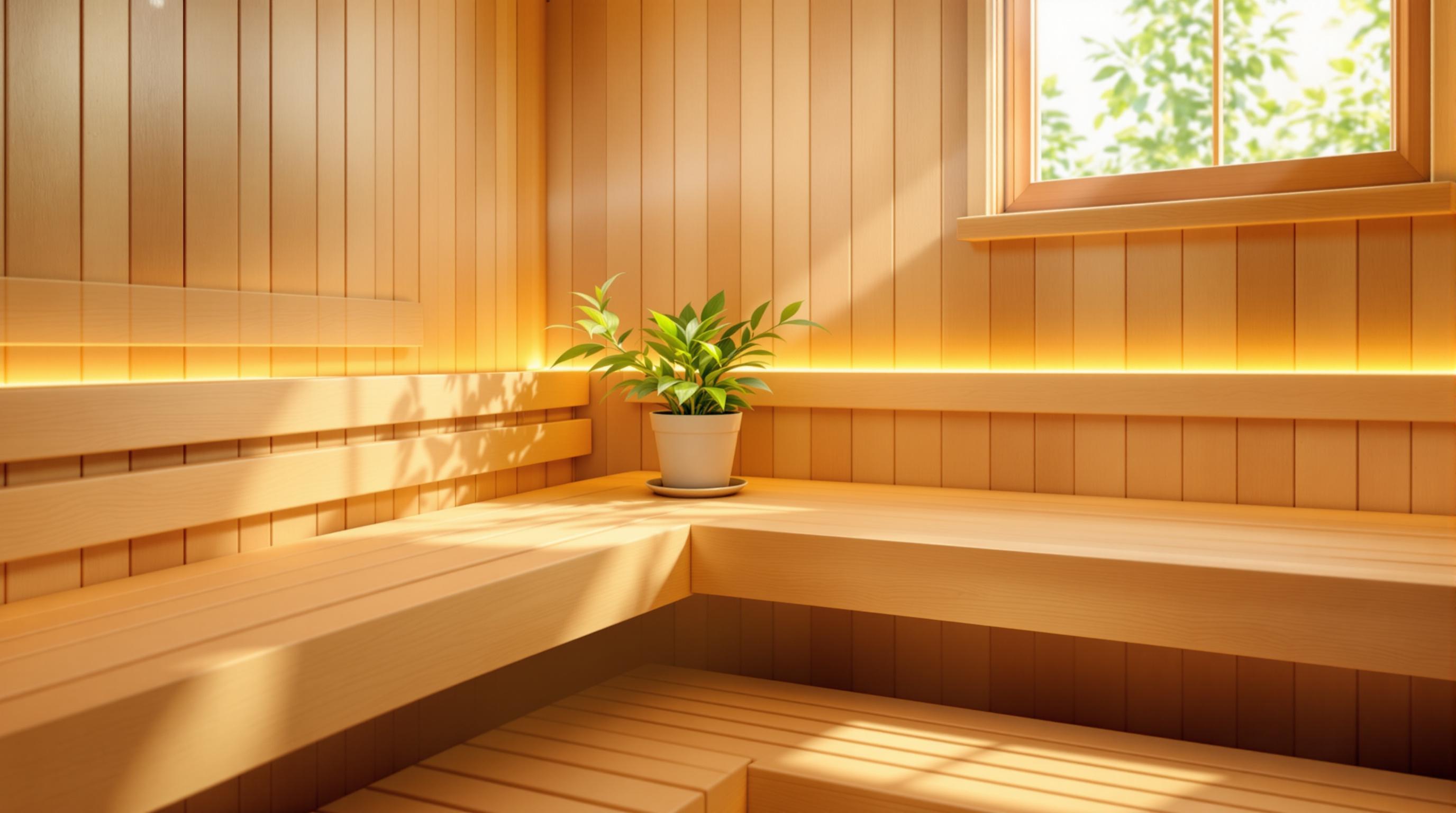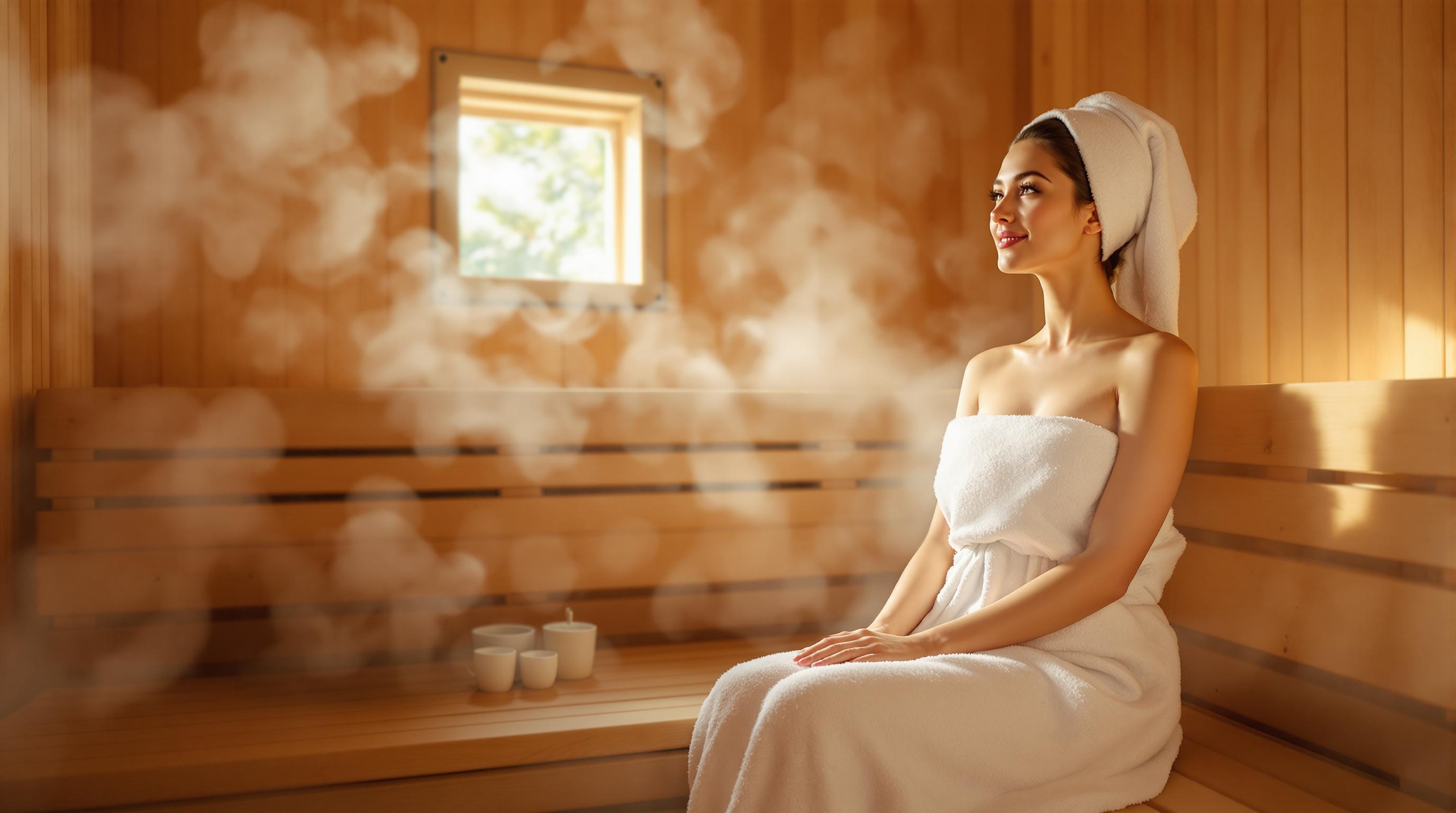Looking for the best material for your sauna storage racks? Here's a quick breakdown:
- Cedar: Durable, moisture-resistant, and aromatic. Low maintenance and long-lasting, but higher upfront cost.
- Birch: Smooth, modern look with decent durability. Requires more upkeep than cedar but is budget-friendly.
- Pine: Affordable but less durable. Needs frequent maintenance and has a shorter lifespan.
Quick Comparison
| Feature | Cedar | Birch | Pine |
|---|---|---|---|
| Moisture Resistance | Excellent | Good | Fair to Poor |
| Maintenance | Every 2-3 years | Annual | Every 6-12 months |
| Initial Cost | High ($80-$120/sq ft) | Medium ($50-$70/sq ft) | Low ($30-$40/sq ft) |
| Lifespan | Long-lasting | Decent with care | Short (3-5 years) |
| Aroma | Strong, pleasant | Mild | Minimal |
For long-term use, cedar is the best option. Birch offers a balance of cost and durability, while pine works for temporary or budget setups. Choose based on your sauna’s usage, humidity level, and maintenance preference.
Products We Recommend for Sauna Builds
1. Cedar
Cedar is a top choice for sauna storage racks, thanks to its natural durability and resistance to moisture. Western Red Cedar, in particular, is well-suited for humid environments due to its natural oils that help prevent decay and fungal growth [2][4].
This wood holds up well under the intense heat and humidity of saunas, making it both practical and long-lasting. Its rich color variations also add a touch of elegance to sauna interiors. As one industry expert puts it:
"Western Red Cedar is a superior sauna wood because it is least hot to the touch, it has the most beautiful color variation, and it has a pleasant aroma" [3].
How Cedar Measures Up
| Characteristic | Performance |
|---|---|
| Moisture Resistance | Excellent - Natural oils prevent rot and mildew |
| Heat Tolerance | High |
| Maintenance | Low - Occasional cleaning and treatment |
| Longevity | Superior - Holds up well for many years |
| Environmental Impact | Positive - Renewable resource |
- Cost range: $50-$100 for a basic shelf, making it a solid mid-range option [1]
- Additional notes: Using kiln-dried cedar improves its hypoallergenic properties and overall performance [6].
Cedar delivers excellent results, but birch offers its own unique benefits in terms of cost and texture, which we'll explore next.
2. Birch
If you're leaning toward sleek, modern aesthetics rather than relying on natural oils, birch is a solid option. Its natural density helps it resist warping even in sauna conditions [5], though it doesn't have the protective oils found in cedar [2][4].
Birch stands out for its light color and smooth texture, making it a great fit for neutral, contemporary sauna designs [1].
Maintenance Tips
To ensure birch storage racks last, proper preparation and installation are key. Here’s what to focus on:
- Use kiln-dried wood for better performance.
- Seal the wood's surfaces to protect against moisture.
- Mount securely to avoid instability [2].
Pairing birch with moisture-resistant hardware can also improve its durability.
While birch requires more maintenance compared to cedar, its clean, modern look makes it a favorite for contemporary styles. Pine, on the other hand, offers a more budget-friendly way to achieve a different balance of aesthetics and practicality.
sbb-itb-3953eb0
3. Pine
Pine is a cost-effective option for sauna storage racks, but it comes with trade-offs. While it saves you money upfront, keeping it in good condition requires consistent upkeep to ensure it lasts.
Durability Concerns
Pine, being a softwood, absorbs moisture more easily compared to cedar or birch. This makes it more prone to warping, decay, and splintering. Unlike cedar, which has natural oils, or birch, known for its density, pine doesn’t naturally resist the tough conditions of a sauna. Some types, like Eastern White Pine and Southern Yellow Pine, handle moisture better but still fall behind cedar in protection.
Maintenance Needs
To keep pine storage racks in shape, follow these steps:
- Initial Treatment: Apply a moisture-resistant sealant regularly.
- Ongoing Care: Inspect frequently to catch issues like wear or damage early.
Cost vs. Value Compared to Cedar and Birch
Pine’s lower price tag comes with higher maintenance demands. Here’s what to consider:
- Maintenance is needed every 6-12 months, while cedar requires attention only every 2-3 years.
- Pine’s lifespan is shorter, typically lasting 3-5 years with proper care.
- Long-term maintenance costs can add up, offsetting the initial savings.
| Aspect | Pine Compared to Other Woods |
|---|---|
| Initial Cost | Low |
| Moisture Resistance | Poor to Fair |
| Maintenance Frequency | High (6-12 months) |
| Expected Lifespan | 3-5 years with proper care |
| Visual Appeal | Light, casual appearance |
Installation Tips
If you choose pine, ensure it’s installed correctly to maximize its lifespan:
- Use stainless steel fasteners to avoid rust stains.
- Place racks in well-ventilated areas.
- Keep them away from direct heat sources.
- Distribute weight evenly for better stability.
For saunas with lighter use or temporary setups, pine can be a reasonable choice despite its limitations.
Advantages and Disadvantages
Choosing the right material for sauna storage racks involves weighing the pros and cons of each option. Here's a breakdown of the main materials and their features.
Cedar: Top-Tier Option
Cedar is known for its natural oils that protect against moisture, rot, and insects without extra treatments. While it has a higher upfront cost, its durability and low maintenance make it a smart long-term investment. Plus, its distinct aroma adds to the sauna experience.
Birch: Balanced Choice
Birch offers a mix of durability and style. Its smooth, light finish gives a modern look, appealing to many sauna owners. Though it doesn’t naturally resist moisture as well as cedar, proper upkeep ensures decent performance. Its mid-range price makes it a practical option for those who want quality without breaking the bank.
Pine: Budget-Friendly Option
Pine is the least expensive choice, but it requires more upkeep and has a shorter lifespan. Its vulnerability to moisture means you may need to replace it more frequently.
| Feature | Cedar | Birch | Pine |
|---|---|---|---|
| Moisture Resistance | Excellent | Good | Fair to Poor |
| Maintenance Frequency | Every 2-3 years | Annual | Every 6-12 months |
| Initial Cost | High ($80-120/sq ft) | Medium ($50-70/sq ft) | Low ($30-40/sq ft) |
| Natural Resistance to Decay | High | Medium | Low |
| Visual Appeal | Rich, warm tones | Light, smooth finish | Light, casual look |
| Aroma | Strong, pleasant | Mild | Minimal |
Key Factors to Consider:
Western Red Cedar often stands out as the best choice for sauna storage racks, thanks to its excellent moisture resistance and protective qualities [1][3]. However, the right material for you depends on:
- How often the sauna is used
- Humidity levels in your area
- Your budget
- Desired look and feel
- Willingness to perform maintenance
For saunas used frequently or located in humid conditions, cedar’s higher cost can pay off in the long run. That said, birch and pine remain practical alternatives for those with different needs or priorities.
Conclusion
When it comes to sauna storage racks, Western Red Cedar stands out as the top pick for those focused on durability and long-term performance. Its natural oils protect against moisture, rot, and insects, while its warm tones and pleasant scent elevate the sauna experience [2][4]. Beyond its aesthetic appeal, cedar's resilience makes it the go-to option for most sauna owners.
For a more budget-friendly yet quality option, birch offers a solid middle ground. Its smooth, light finish adds a modern touch, but it does require more upkeep compared to cedar. On the plus side, birch is easier on the wallet, costing around $50-70 per square foot, compared to cedar's $80-120.
If you're looking for an economical solution, pine is worth considering. It's a practical choice for temporary setups or saunas that aren’t used often. However, pine’s lower resistance to moisture and decay means you’ll likely face more frequent maintenance and replacements.
To get the most out of your investment, think about how and where your sauna will be used. Cedar thrives in humid conditions, while drier environments might allow for more material options.
Here’s a quick breakdown to guide your decision:
- For long-term use: Cedar is unmatched, offering years of low-maintenance reliability.
- For balanced budgets: Birch combines affordability with decent durability.
- For budget-conscious setups: Pine works well for temporary or less-used saunas.
Your choice will ultimately depend on your specific needs and priorities.
FAQs
What type of wood is best for a sauna?
When comparing cedar, birch, and pine, Western Red Cedar stands out as the top choice for sauna storage racks [1][3]. Here's why cedar often takes the lead:
- It naturally resists decay and moisture.
- Handles high heat conditions exceptionally well.
- Emits a pleasant and soothing aroma.
- Maintains its shape and size over time.
For the best results, always use kiln-dried wood for your sauna. This process enhances the wood's durability under sauna conditions [5][3].
| Feature | Advantage |
|---|---|
| Moisture Resistance | Excellent |
| Natural Oils | Abundant |
| Color Stability | Long-lasting |
| Maintenance Needs | Low |
| Insect Resistance | Naturally repellent |


